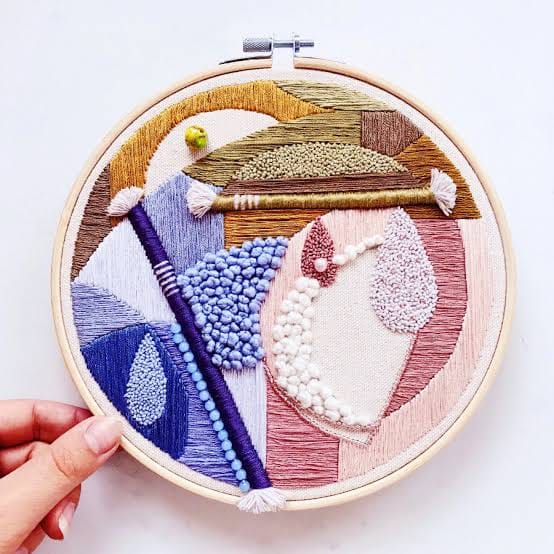Mastering the Art of Embroidery - Exploring 15 Essential Stitches

Introduction to Embroidery Stitches
Embroidery stitches are the building blocks of embroidery, used to create beautiful designs and patterns on fabric. They are the foundation upon which all embroidery designs are built, and mastering them is essential for creating intricate and stunning pieces.
The Importance of Embroidery Stitches
Mastering various stitches can help you create intricate and stunning embroidery pieces. Each stitch has its unique characteristics, and learning how to use them effectively can open up a world of creative possibilities. From simple running stitches to complex satin stitches, each stitch plays a crucial role in bringing your embroidery design to life.
Why Learn Embroidery Stitches?
Learning embroidery stitches can help you:
- Create intricate designs and patterns with precision and accuracy
- Experiment with different textures and effects
- Develop muscle memory and improve your stitching speed
- Enhance your overall embroidery skills and creativity
1. Running Stitch - The Foundation of Embroidery
The running stitch is the most basic embroidery stitch, used for outlining designs and filling in large areas. It is the foundation of most embroidery techniques and is a crucial stitch to master for beginners.
Understanding the Running Stitch
The running stitch involves making straight stitches on the fabric, moving the needle in a consistent, even motion. This stitch is versatile and can be used for a variety of applications, from simple embroidery designs to complex patterns.
Key Characteristics of the Running Stitch
The running stitch has several key characteristics that make it an essential stitch in embroidery:
- Simple and easy to learn
- Used for outlining and filling in large areas
- Can be worked in any direction
- Can be used with a variety of thread weights and colors
2. Backstitch - Perfect for Outlines and Details
Understanding the Backstitch
The backstitch is a fundamental stitch in embroidery, used for creating outlines, details, and text. It is a versatile stitch that can be used to create a variety of effects, from simple to intricate designs.
How to Work the Backstitch
To work the backstitch, you will need to make straight stitches, moving the needle in a reverse motion. This stitch is worked from right to left, making it ideal for creating straight lines and details.
Tips and Variations
Here are some tips and variations to help you master the backstitch:
- Use a sharp needle and a thin thread to create a smooth, even line.
- Vary the length of your stitches to create different effects, from fine details to bold outlines.
- Experiment with different thread colors to add depth and interest to your design.
3. Straight Stitch - Simple yet Versatile
Understanding the Straight Stitch
The straight stitch is a fundamental stitch in embroidery, used for creating straight lines and details. It is a basic stitch that serves as a foundation for more complex stitches and designs.
How to Work the Straight Stitch
To work the straight stitch, follow these simple steps:
- Bring the needle up through the fabric at the starting point of the line you want to create.
- Insert the needle back into the fabric at a consistent distance away, making a straight stitch.
- Continue making straight stitches, moving the needle in a consistent, even motion along the line.
Tips and Variations
The straight stitch can be worked in various lengths and densities to achieve different effects. Experiment with different stitch lengths and spacing to add texture and interest to your embroidery designs.
4. French Knot - Adding Texture and Dimension
Discover the Beauty of French Knots in Embroidery
The French knot is a decorative stitch used to add texture and dimension to embroidery designs. This versatile stitch can be used to create intricate details, add depth to floral patterns, and even form the center of flowers.
Mastering the French Knot Technique
To create a French knot, follow these simple steps:
- Wrap the thread around the needle to create a knot.
- Insert the needle into the fabric where you want the knot to be placed.
- Gently pull the needle through, leaving a small loop on the front of the fabric.
- Adjust the knot as needed to achieve the desired size and texture.
Tips and Variations for French Knots
Experiment with different thread colors and textures to add unique effects to your embroidery. You can also vary the size of the knot by adjusting the number of wraps around the needle.
5. Stem Stitch - Smooth and Versatile
Understanding the Stem Stitch
The stem stitch is a fundamental stitch in embroidery, used to create smooth, flowing lines on fabric. It's a versatile stitch that can be used for outlining designs, creating details, and even filling in large areas.
How to Work the Stem Stitch
To work the stem stitch, follow these simple steps:
• Start by bringing your needle up through the fabric at the beginning of the line you want to create.
• Insert the needle back into the fabric about 1/4 inch away, making a straight stitch.
• Continue making straight stitches, moving the needle in a consistent, even motion along the line.
• Keep the tension even, making sure the stitches are not too tight or too loose.
Tips and Variations
• To create a thicker line, simply make multiple stem stitches side by side.
• To create a more textured look, vary the length and spacing of the stem stitches.
• Experiment with different thread colors and weights to add depth and interest to your design.
6. Satin Stitch - Shiny and Smooth
The Beauty of Satin Stitch
The satin stitch is a decorative stitch used to create smooth, shiny surfaces in embroidery. This stitch is a fundamental element in creating a beautiful and elegant design.
Technique and Tips
It involves making straight stitches on the fabric, moving the needle in a consistent, even motion. The key to achieving a smooth and shiny surface is to maintain a consistent tension and even spacing between the stitches.
7. Chain Stitch - A Foundation for Other Stitches
Understanding the Chain Stitch
The chain stitch is a basic stitch used as a foundation for other stitches in embroidery. It's a fundamental stitch that every embroiderer should master, as it's a building block for more complex stitches.
How to Create a Chain Stitch
The chain stitch involves making looped stitches on the fabric, moving the needle in a consistent, even motion. To create a chain stitch, follow these steps:
- Insert the needle into the fabric and pull it out about 1/4 inch away.
- Re-insert the needle back into the fabric about 1/4 inch away from where it came out.
- Pull the needle all the way through, leaving a small loop on the front of the fabric.
- Continue making these looped stitches, moving the needle in a consistent, even motion.
Importance of the Chain Stitch
The chain stitch is an essential stitch in embroidery because it provides a foundation for other stitches. It's used as a base for stitches like the feather stitch, herringbone stitch, and more. Mastering the chain stitch will help you create a smooth, even base for your embroidery designs.
8. Detached Chain Stitch - A Versatile Stitch
Understanding the Detached Chain Stitch
The detached chain stitch is a versatile stitch used for creating details and textures in embroidery. This stitch is an excellent choice for embroiderers of all skill levels, from beginners to experts, due to its simplicity and versatility.
How to Work the Detached Chain Stitch
To work the detached chain stitch, start by bringing your needle up through the fabric at the desired starting point. Make a looped stitch on the fabric, keeping the loop small and even. Move the needle in a consistent, even motion, making sure to keep the tension steady. Bring the needle back down through the fabric, securing the loop in place.
Uses of the Detached Chain Stitch
The detached chain stitch is a versatile stitch that can be used for a variety of embroidery techniques, including:
- Creating delicate details, such as leaves or flowers
- Adding texture to embroidery designs
- Making bold, statement pieces
9. Lazy Daisy Stitch - A Simple yet Effective Stitch
The lazy daisy stitch is a simple stitch used for creating daisy-like designs in embroidery. This stitch is perfect for beginners and experienced embroiderers alike, as it requires minimal effort but produces a beautiful, eye-catching result.
How to Create the Lazy Daisy Stitch
The lazy daisy stitch involves making looped stitches on the fabric, moving the needle in a consistent, even motion. To create this stitch, follow these steps:
• Start by bringing your needle up through the fabric at the center of where you want your daisy to be.
• Make a loop with your thread, keeping it on the front of the fabric.
• Insert your needle back into the fabric at the edge of the loop, about 1/4 inch away from where it came up.
• Pull the thread gently to create a small, even loop.
• Repeat steps 2-4, moving around the center of the daisy in a circular motion, until your daisy is the desired size.
Tips and Variations
• Use a consistent tension when making the loops to ensure even stitches.
• Experiment with different thread colors and weights to create varying effects.
• Combine the lazy daisy stitch with other stitches, such as the French knot or straight stitch, to create more complex designs.
10. Fly Stitch - A Quick and Easy Stitch
Understanding the Fly Stitch
The fly stitch is a quick and easy stitch used for creating details and textures in embroidery. This versatile stitch is ideal for beginners and experienced embroiderers alike, as it can be worked in a variety of ways to achieve different effects.
Working the Fly Stitch
To work the fly stitch, start by making straight stitches on the fabric, moving the needle in a consistent, even motion. The key to this stitch is to keep your stitches evenly spaced and the same length, which will create a smooth, textured look.
Tips and Variations
Here are a few tips and variations to keep in mind when working the fly stitch:
- Use the fly stitch to create details such as veins on leaves, branches on trees, or textures on fabric.
- Experiment with different lengths and spacing of stitches to achieve varying textures and effects.
- Combine the fly stitch with other stitches to add depth and interest to your embroidery design.
Conclusion - Mastering Embroidery Stitches
Embroidery is an art form that requires patience, dedication, and a willingness to learn. Mastering various embroidery stitches can help you create intricate and stunning embroidery pieces. With practice and patience, you can unlock your embroidery potential and create beautiful works of art.
The Power of Practice
Practice is key to mastering embroidery stitches. The more you stitch, the more comfortable you'll become with the different techniques and the easier it will be to create complex designs.
Unlocking Your Potential
As you master each stitch, you'll unlock your embroidery potential and be able to tackle more complex projects. Don't be afraid to experiment and try new things – it's all part of the learning process.
A World of Possibilities
With 15 essential stitches under your belt, the possibilities are endless. You can create beautiful embroidery pieces for yourself or as gifts for others. Whether you're a beginner or an experienced embroiderer, there's always room to learn and grow.













Comments ()